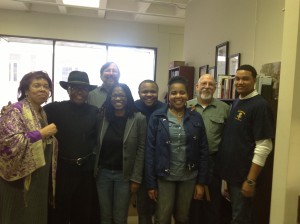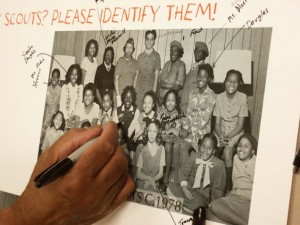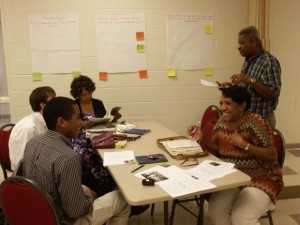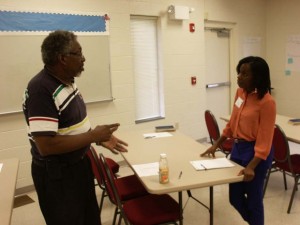Rethinking diversity: Who does history belong to?
08 January 2015 – Angela Thorpe
public engagement, education, profession, employment, training, race, graduate students, new professionals

Three cohorts of student interns at Eleanor S. Brockenbrough Archives. Pictured are Teresa Roane, Library Director; Sgt. Major Abdur Alimi-Hayes, Eric Richardson, Donna Nelson, Torren Gatson, Ronnica Williams, Ed (independent researcher), and Andrew Winters. Photo credit: Rhonda Jones
This is the final post in a series on issues of diversity in the public history field. You can find the previous posts in the series here.
As public historians, we have many responsibilities, but, as a baseline, we are charged with making history relevant, meaningful, and accessible to amateur historians, students, families, and scholars alike. To do this effectively, it is necessary to consider the “who” behind the “what.”
As this series demonstrates, if our institutions are to remain relevant to a public with evolving needs, we must include individuals within our ranks that have a multiplicity of backgrounds. It is critical that these individuals are in turn capable of interpreting multiple narratives, engaging with all parts of society, including those who have been marginalized, and expressing history in innovative ways. Consider the Minnesota Historical Society’s American Indian Museum Fellows program. According to program head Chris Taylor, the program forces students to confront their relationship with American history head-on. Yet it also equips them with the tools to reinterpret “traditional” narratives and transform how historical institutions are preserving and engaging with Native American history and culture. This ultimately prepares future public historians to enter the field with invaluable sets of professional skills.
In connecting with public history professionals through this series, and reflecting on comments and feedback from others, I have been struck by the notion that maybe what we’re dealing with is deeper than diversity. I believe “diversity” is a narrow term. This conversation isn’t about quotas or color or race. It’s about putting practitioners in place who are equally capable of meeting the needs of historical institutions and engaging with public need, based on ability, cultural understanding and sensitivity, and experience, among other factors.
A better term, perhaps, is inclusion. Although inclusivity encompasses diversity by nature, it also helps us consider a number of other things as well, including skills beyond merely historical research. If we take a step back and focus on making our institutions more inclusive, rather than more diverse, we will cultivate a culture of public historians more equipped to offer programs and services that are accessible to, and inclusive of, an evolving public.
Based on my interviews we can do this in three major ways: 1) getting people through the public history pipeline, 2) making conscious decisions about who we bring into our institutions to practice public history, and 3) continuing this dialogue.

History comes alive as Warnersville residents identify photographs at a memory and story-sharing event in Greensboro, NC. Photo credit: Greensboro Historical Museum
So how do public historians even become public historians? Before we answer this question, we must reassess the “public history pipeline.” We’ve got to make our graduate programs more accessible and thus more inclusive of people from different backgrounds. Outreach is essential. Both Modupe Labode and Juanita Moore argue that graduate programs could make stronger alliances with colleges and universities to make undergraduates more aware of what public history is and to get students into their programs, and hopefully, the profession. Labode also suggests that graduate programs might make more efforts to put funding towards supporting students from different backgrounds or implement evidence-based recruiting strategies to demonstrate how training students from different backgrounds affects public history. In addition, Rhonda Jones and Chris Taylor demonstrate how partnering with historical institutions prepares students for, and encourages them to enter, the field by the very nature of their work.
In a similar vein, graduate programs–and the profession in general–should be more inclusive of individuals from different paths of study. In her interview, Juanita Moore stated that public historians exist outside the bounds of history. People from backgrounds outside of history or the humanities come equipped with different skills that can complement professionals from strict history or public history backgrounds, leading to innovation within the institution.

Greensboro Historical Museum interns engage with Warnersville leaders at Shiloh Baptist Church in Greensboro, NC. Photo credit: Greensboro Historical Museum
Next, when hiring, institutions should generally be more inclusive of people’s backgrounds and consider to what narratives they might be able to contribute. Institutions should also be attentive to, and inclusive of, communities’ needs when making these decisions. For example, I recently worked with the Greensboro Historical Museum to help develop an exhibit centered on a local historic black community. I was primarily responsible for engaging with this community in a number of ways, including talking to people at churches and community centers, holding community listening sessions and storytelling events, and recruiting a team of “community curators” to ensure that residents’ voices were present throughout the exhibition development process. The museum needed someone who was able to engage with a marginalized community in ways its staff could not. Conscious and deliberate hiring decisions like these help to build trust between museums and communities, which in turn has positive residual effects, like increased membership, more donors, and a general increase in public engagement overall.
Of utmost importance, I think, is this dialogue. Yet it’s not enough to just talk–we have to implement changes within our institutions as well. We also have to consider that this conversation is relevant to all in the field. Taking a note from Rhonda Jones, we should seek out opportunities to engage with this conversation outside of our comfort zones. For example, what if we engaged with this dialogue not only at the National Council on Public History (NCPH) annual meeting, but at meetings of the Association for the Study of African American Life and History, American Alliance of Museums, American Historical Association, and American Association for State and Local History as well? How might such widespread dialogue shape public history or the way historically centered institutions everywhere engage with inclusion and diversity?

I speak with a former resident of Warnersville, a historic black community in Greensboro, NC, at a local church. Photo credit: Greensboro Historical Museum
In my interview with Chris Taylor, he made a very powerful point: “Diversity is a fact. Inclusion is how we leverage that diversity.” Overall, I feel that inclusion is making conscious, deliberate, and informed decisions about how we incorporate the talents of people from diverse backgrounds within our institutions.
If we intend to carry out our responsibilities as public historians to the best of our abilities–to make history informative, accessible, and meaningful to all–we have to be conscious about who we bring into our institutions. As long as we don’t lose sight of the basic meaning and responsibilities of our profession, we will do what we must to evolve. I am sure of it.
~ Angela Thorpe is a graduate of the Museum Studies MA program at the University of North Carolina at Greensboro. She is an oral history researcher with The HistoryMakers African American video oral history archive in Chicago, IL.



